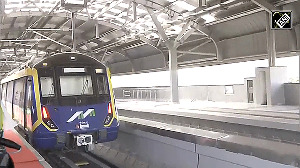Being in the driver's seat gives most people a whole new perspective, as Rajiv Bajaj is finding out after he assumed charge as managing director of Bajaj Auto a few months back.
Two years ago, when working under his charismatic father Rahul Bajaj's stewardship of the company, he had said his goal was to upstage the decade-long domination of mobike king Hero Honda, which controlled more than half the mobike market in the country, and to make Bajaj Auto the number one two-wheeler company in the country.
Twenty four months later, Bajaj is less pugnacious about the leader. In his small terrace garden adjacent to his office in Pune, as the first monsoon rains come lashing in, I ask him the same question again: What are his immediate priorities?
Bajaj shrugs. "We are not looking at quantity," he says. "Honda globally sells four to six times the number of bikes we do, so numbers don't matter." No? "Our aim," he continues, "is to make the next most powerful bike, create a new technological benchmark, make bikes powered with over 200cc engines (it is launching a 220cc Pulsar soon) and sell our products globally."
Bajaj Jr knows what he's talking about. Unlike his brother, executive director Sanjiv Bajaj, who spends most of his time on flights to oversee exports, Rajiv Bajaj is routinely to be found on the test tracks or with his R&D team, determined to transform Bajaj Auto into a global auto and two-wheeler powerhouse.
He wants to see the Bajaj logo emblazon across Latin America, South-east Asia, Africa, China and the Middle East - by leveraging the technological prowess that has been built from scratch over the last few years after the scooter major had all but collapsed under the onslaught of the Japanese mobike revolution.
Nor does he hide his global ambition. "Currently we have a 32 per cent market share in India, and there's no reason why we cannot aim for similar market shares in global markets leaving out the US, Europe and Japan," he points out.
The logic is dictated by simple mathematics - 80 per cent of all two-wheelers manufactured globally are sold in markets outside India.
His change of heart, analysts suggest, emanates from the fact that the gap between Hero Honda, his main rival, and Bajaj Auto is closing in. Bajaj Auto's market share in mobikes has grown from around 30 per cent last year to 34 per cent this April at the expense of its competitors.
Says Arvind Jain, research analyst in Religare: "Hero Honda sells 270,000 bikes a month, and Bajaj 200,000. Given Bajaj's aggression, we forecast that gap will come down to 30,000-20,000 in the next 12 months."
Some of those numbers will come from his global thrust. Though Bajaj Auto already exports two-wheelers to markets like Sri Lanka, Columbia, Nigeria and Bangladesh, it is now targeting key markets much more seriously.
For starters, it wants to crack the Japanese-dominated Indonesian two-wheeler market, the third-largest in the world. The other target is more distant Mexico - where value-for-money bikes reign supreme.
He is also monitoring the fragmented Chinese market where he might get in with a joint venture partner. Says Bajaj: "At the moment we are importing components and understand how Chinese consumers are evolving."
Still, he's treading slowly and is in no hurry to set up manufacturing plants around the globe. Instead, he wants to use India as his manufacturing hub by leveraging scale as well as cost, and export products.
That, says Bajaj, is the international trend, with auto companies closing manufacturing centres to consolidate. And that's how most Japanese car makers entered the US - first exporting the product and setting up manufacturing plants only a decade later.
And that is why he is building big volume capacity locally. The company is investing Rs 1,500 crore (Rs 15 billion) to take up its two-wheeler capacity from 3.5 million to over 5 million, which includes setting up a new plant in Uttaranchal.
The gameplan is to have fewer models but larger volumes, and the rules are simple: if a model does not sell more than 10,000 a month, it isn't good enough to continue. Any wonder that products like Sunny, Boxer, Wind and Legend have been discontinued?
It is also working on newer technology for its three-wheelers to reengineer outdated, fuel-guzzling models. It has developed a commercial four-wheel platform (which is not a downsized truck) to provide smart solutions for consumers looking for light commercial vehicles. The rollout in 2009 is, again, targeted at the export market.
For now, Bajaj Auto exports only 12 per cent of its production, and the target is to increase its foothold there to 20 per cent in the coming year. Its largest challenge is Japanese manufacturers who have a firm hold over the international market.
In fact, analysts argue that Bajaj is pushing for global might because sales of two-wheelers in the country are expected to stagnate as the country develops cheaper cars.
Says Religare's Jain: "Two-wheeler sales will peak in India in the next three to four years, so you need to hedge your bets and get into emerging and underdeveloped markets. That might also be the reason for Bajaj Auto wanting to diversify into the four-wheeler market with LCVs.
"Nor is the Japanese stranglehold over the scooter and mobike market unlikely to loosen in India, where both Honda and Suzuki are flexing their muscles.
"Agrees Nimesh Shah, managing director of Fortune Financial Services, which tracks the industry, "I think Bajaj Auto is hedging its bets because, beyond a point, it won't be able to close the gap with a formidable company like Hero Honda in the country."
One reason the global market might prove tough to crack is the way the distribution is set up.
Explains Amit Kasat, analyst in Motilal Oswal, a leading company, "The key challenge will be tying up financing companies (as the Japanese biggies have done) as 95 per cent of all two-wheelers in global markets are financed, unlike in India where it is 50 per cent. Without that, you can't sell. The other challenge is to create an exclusive dealership network and work aggressively on building the Bajaj brand."
For now, Bajaj appears to be averse to taking undue risks and is identifying countries that suggest easier entry. For instance, the two-wheeler market in Mexico is a tenth the size of Brazil, and that is why most Japanese manufacturers have a manufacturing base there. Mexico is serviced by anchor dealers.
"The priority given to this market by the Japanese is very low so it offers us an entry point," insists Bajaj. So he will drive into underserved Mexico with Discover and CT 100, pricing the bikes 5-15 per cent below Japanese competitors.
A tougher challenge will be Indonesia, where Honda, Suzuki and Yamaha dominate with step-through scooters. But Bajaj senses the market could be switching to mobikes and wants to take advantage by being the first mover there.
Unlike in Mexico, the objective here is to establish Bajaj as a technologically savvy company that produces quality products. It has chosen its high-end bikes Pulsar and the Avenger accordingly.
In both countries, Bajaj has eschewed setting up manufacturing plants, though it might consider assembly facilities. The reason is two-fold - duties on CKDs is only 10 per cent, but more importantly, the company would rather invest in building a dealership network and after-sales service than tie up its spends on a manufacturing unit.
"Initially, our effort would be to invest in marketing," rationalises Bajaj. But even he agrees that his hopes lie in the technological edge his company can provide over other competitors.
Bajaj Auto was able to change customer perception with the launch of digital twin spark ignition, which offered more power, lower fuel consumption and improved emissions on its mobikes. The gamble worked. Fifty per cent of Bajaj Auto sales are based on this technology and are a key driver for its gains in market share.
It has helped the company dominate the premium end of the market and improve margins - the premium segment constitutes 76 per cent of its sales compared to only 10 per cent three years ago.
But Bajaj's run in the segment might not last forever. Last week Hero Honda launched a mobike with a fuel injection system that offers greater efficiency, far ahead of Bajaj Auto's stated goal to offer a similar product combined with DTSFI (Bajaj says it is a different technology and is far more advanced).
Points out P S Sunder, general manager marketing and sales in Hero Honda, "Customers don't buy technology, they buy the bike. We have launched fuel injection bikes ahead of anyone else and offer real time mileage indicators, which no one else does, and our Quantum engines offer more power. And we are introducing eight new models this year."
Hero Honda's strategy appears to be that of a winner. Says Amit Kasat, "Hero Honda has introduced this technology in its bread-and-butter 125cc bikes. Bajaj Auto is introducing DTSFI in its 220cc upper-end bikes.
"If the Hero Honda technology works, the sheer volumes at that level will drive the cost of technology down and it will be very difficult for competitors to take them on."
He argues that the gain in market share by Bajaj Auto is bound to slow down, given how difficult it will be to break Hero Honda's domination of the executive segment.
As the domestic competition between the two giants hots up, it's clear that Bajaj's biggest challenge, in India and globally, are Japan's big boys.
As the Indian major gets eyeball-to-eyeball with them, the domestic parleys will serve as a primer to the war that's about to go global. Keep cheering.
Zen and the philosophy of being Rajiv Bajaj
He believes what they teach at Harvard is too complex, and business isn't that complicated. His own philosophy is somewhat more simplistic and based - don't laugh - on homeopathy.
But Bajaj swears it makes sense. "Homeopathy talks about a holistic approach to the body; if you are losing hair, for instance, the problem might lie elsewhere," he clarifies. "That is my approach to business."
The other key component of homeopathy is that it rubbishes the Western practice of one medicine for everyone's ailments. "Homeopathy respects individualism," he says.
"I believe we must respect the individuality of those who work with us. People don't need to be managed - inventories need to be managed - they have to be lead by demonstrative leadership."
Bajaj rarely misses his morning yoga, and is just as clear that he prefers to work directly with his team of top 10-15 executives with whom he interacts regularly, leaving the rest to others.
"Running a company is simple, I don't spend more than four hours on office work."
For the rest of his time there "I might be reading books", he says. Almost reclusive, Bajaj prefers to spend his time meeting dealers, but also clarifies that his executives don't have a cool time since most of them, especially in R&D, have a 14-hour slog every day.
What excites him most is new frontiers in technology - though, ironically, he's no gizmo freak, even refusing to carry a mobile phone on him. So what's hot on his agenda?
An ABS brake system (like in cars) for two-wheelers, he says, and liquid cool engines, mobikes with a digital dashboard with diagnostic abilities to indicate which part of the engine has a problem - in real time...
Rajiv speak
On Ratan Tata's Rs 100,000 car project and how it will affect mobikes
No one knows what the car will be like, whether it will have a plastic body, its configuration... Even at Rs 100,000 it will not have a bike's fuel efficiency of 70 km/litre, or maintenance costs as low as Rs 100 a month. The most important element for a customer is how much he has to fork out every month on running the vehicle and paying the EMI. Obviously, there is no comparison.
On his technology tie-up with Kawasaki
I will continue with Kawasaki as long as I cannot make a bike faster than theirs. They are my teachers. We are working on a 300cc bike.
I don't know if there is a market for it, but that is what critics had said about the Pulsar. Remember, the seven series of BMW is its highest seller.
Does the company regret its abstinence from the passenger car market
Knowledge is power. I will never get into car making if I cannot develop it myself and have to depend on someone else. That would be a fatal mistake.







 © 2025
© 2025